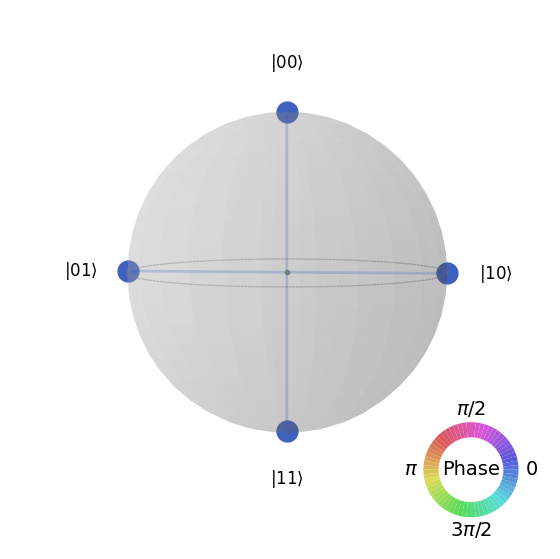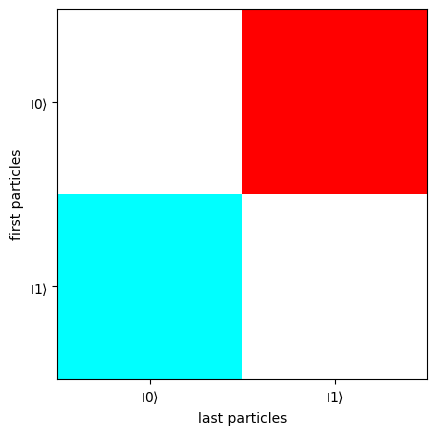You're reading the documentation of the v1.0. For the latest released version, please have a look at v1.2.
Statevector converter
Overview
The Statevector converter enables seamless conversion of quantum states between different quantum computing frameworks:
Perceval: Photonic quantum computing framework
Qiskit: IBM’s quantum computing toolkit
QuTiP: Quantum Toolbox in Python
For a detailed example of working with quantum states in Perceval, you can read the “Graph_States_generation_and_display.ipynb” notebook from Perceval repository.
[1]:
from perceval import Encoding, StateVector, StateGenerator
from perceval_interop import StatevectorConverter
from qiskit.visualization import plot_state_qsphere
from qutip import plot_schmidt
Understanding Encoding Types
It is important to consider that Qiskit only implements Statevectors that represent n-qubits states. In order to do so we propose a converter to make a StateVector from Perceval compatible with a Statevector from Qiskit that can be interpreted by qsphere. A state in dual rail encoding like \(|0,1,0,1,0,0,0,1,0,0 \rangle\) from Perceval can’t be directly interpreted by Qiskit.
Therefore, the type of encoding (RAW, DUAL_RAIL, POLARIZATION…) needs to be given to the converter and an optional parameter ancillae corresponding to the list of modes that we don’t consider in the multi-qubits state.
[2]:
# Initialize the converter with dual rail encoding
# This tells the converter how to interpret the photonic states
converter = StatevectorConverter(encoding=Encoding.DUAL_RAIL)
Converting Perceval States to Qiskit
We can then use the converter to convert any state vector from Perceval to Qiskit.
Let’s create a superposition state representing 2 qubits in dual rail encoding:
[3]:
# Create a 2-qubit superposition state using dual rail encoding
# Each logical qubit uses 2 modes: |0⟩ = |1,0⟩ and |1⟩ = |0,1⟩
# So for 2 qubits we need 4 modes total
state_vector = StateVector("|0,1,0,1>") + StateVector("|0,1,1,0>") + StateVector("|1,0,0,1>") + StateVector("|1,0,1,0>")
print("Original Perceval state:")
print(state_vector)
# Convert to Qiskit format
qiskit_sv = converter.to_qiskit(state_vector)
print(f"\nConverted Qiskit statevector:")
print(qiskit_sv)
Original Perceval state:
0.5*|1,0,1,0>+0.5*|1,0,0,1>+0.5*|0,1,1,0>+0.5*|0,1,0,1>
Converted Qiskit statevector:
Statevector([0.5+0.j, 0.5+0.j, 0.5+0.j, 0.5+0.j],
dims=(2, 2))
plot_state_qsphere from Qiskit [1] can be used for a graphical representation of the state.
[4]:
plot_state_qsphere(qiskit_sv)
[4]:

Bidirectional Conversion
After defining a converter, it is also possible to do the conversion the other way around using the to_perceval method.
Let’s demonstrate both directions:
[5]:
# Convert back from Qiskit to Perceval
pcvl_sv_restored = converter.to_perceval(qiskit_sv)
print("Restored Perceval state:")
print(pcvl_sv_restored)
# Verify the conversion is correct by comparing with original
print(f"\nOriginal and restored states are equivalent: {state_vector == pcvl_sv_restored}")
Restored Perceval state:
0.5*|0,1,0,1>+0.5*|0,1,1,0>+0.5*|1,0,0,1>+0.5*|1,0,1,0>
Original and restored states are equivalent: True
QuTiP Integration
We also provide conversion to QuTiP (Quantum Toolbox in Python) with the same converter. QuTiP is a popular Python library for simulating open quantum systems. For instance, we can represent a Bell state \(|\Psi^->\) in polarization encoding from Perceval with the function plot_schmidt from qutip [2] :
[6]:
# Bell state in Perceval
generator = StateGenerator(Encoding.POLARIZATION)
pcvl_bell = generator.bell_state("psi-")
print(pcvl_bell)
-0.707*|{P:V},{P:H}>+0.707*|{P:H},{P:V}>
[7]:
# Conversion
converter = StatevectorConverter(encoding=Encoding.POLARIZATION)
qutip_bell = converter.to_qutip(pcvl_bell)
# Plot
plot_schmidt(qutip_bell)
[7]:
(<Figure size 640x480 with 1 Axes>,
<Axes: xlabel='last particles', ylabel='first particles'>)

This plot function allows to have a better visualization of entanglement.
The to_perceval method is compatible with both Qiskit and QuTiP statevectors, making it easy to work across different quantum computing ecosystems.
[8]:
# Comparing bidirectional conversion from Qutip
print("QuTiP statevector:")
print(qutip_bell)
# Convert back from QuTiP to Perceval
pcvl_from_qutip = converter.to_perceval(qutip_bell)
print(f"\nRound-trip conversion (QuTiP): {pcvl_bell == pcvl_from_qutip}")
QuTiP statevector:
Quantum object: dims=[[2, 2], [1, 1]], shape=(4, 1), type='ket', dtype=Dense
Qobj data =
[[ 0. ]
[ 0.70710678]
[-0.70710678]
[ 0. ]]
Round-trip conversion (QuTiP): True
Reference
[1] https://qiskit.org/documentation/stubs/qiskit.visualization.plot_state_qsphere.html